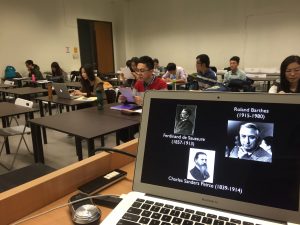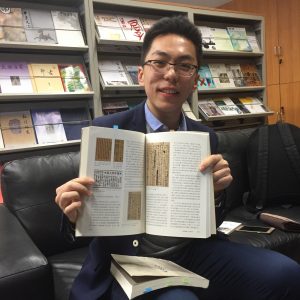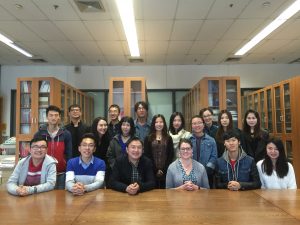Dr. Heather Shirey, Associate Professor and Director of Graduate Studies, Art History, spent the spring semester at Tsinghua University in Beijing, China. Her semester in China was made possible by support from the Fulbright-Terra Foundation Award in the History of American Art. This is the first of three blog posts from Dr. Shirey.
Just as classes at the University of St. Thomas were getting underway in the spring 2016 semester, I was packing up my family to move to China. With the support of the Fulbright-Terra Foundation Award in the History of American Art, I spent five months at Tsinghua University in Beijing. Tsinghua is one of China’s top universities, and entry into the art history graduate program is extremely competitive. The students at Tsinghua have worked very hard to earn a spot in the program, and they are confident, ambitious, and highly capable.
I was assigned to teach two graduate-level courses at Tsinghua. The first was Methods and Theories—a course I enjoy and feel comfortable with after teaching it several times here at UST. In this course we applied various theories and methods to gain an understanding of some canonical works of art from the United States, such as Grant Wood’s American Gothic, a painting the students found fascinating due to the context of the Great Depression. The second course focused on Modern and Contemporary art with an emphasis on African American art from the 20th century.
My ability to communicate in Chinese is limited—I can order dinner and carry on a simple conversation with other parents at the playground, but when it comes to speaking in an academic context, I am lost. Fortunately for me, though, one of the goals of the Fulbright program is to help students improve their skills in English through academic work. For that reason, I taught entirely in English with occasional assistance from a student interpreter.
There was a great deal of variation amongst the students in terms of language abilities. I had some students who could read, write, and speak English with near-native fluency. Impressively, these students were very prepared to engage with the material at a sophisticated level. They wanted and deserved to be challenged to think critically and to write at a high level that would be accepted by academic audiences internationally. At the same time, there were also students in the class with more basic levels of English-language competency. As would be expected, these students tended to focus on basic comprehension rather than on a critical analysis of the material. It was challenging to meet the needs of these diverse students in one class. Breaking into smaller groups for discussion activities, using peer-to-peer teaching, and harnessing technology like We Chat helped us overcome some of these difficulties.
Students were very interested in studying the art of the United States. Some of our best conversations focused on the role of public art in the United States as compared to China. Contrasting approaches to memorialization in China and the US, for example, led to some striking conversations. The topic of race and visual representation was also very productive. China is increasingly involved in economic and political relationships with African nations, and I think there is a problematic tendency in contemporary Chinese popular culture to summon a body of negative stereotypical imagery that emerged in 19th century America and apply it to the representation of contemporary African people. My students in China were often unfamiliar with the history of this imagery, and so together we developed a framework for critiquing negative stereotypes that appear in popular visual culture.
Art History graduate students in China, like their peers in the USA, sometimes feel tired, overworked, and concerned about their future job prospects. There are many highly educated, qualified job candidates entering the job market, and wages in the fields of museums and education are lower than in other careers. As in the United States, Tsinghua graduate students often seek internships and study abroad opportunities to help prepare for a competitive job market. At the same time, contemporary Chinese art is increasingly popular in the global market, and the country is also experiencing a great deal of growth in museums and other educational and cultural institutions. Students generally feel optimistic about the future because of this.




